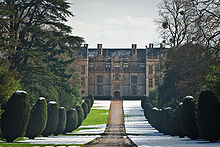- Clifton Maybank
-
Coordinates: 50°55′16″N 2°36′07″W / 50.921°N 2.602°W Clifton Maybank is a hamlet in west Dorset, England. It is perhaps best known for Clifton Maybank House, a country house with surviving Tudor fabric.
Contents
Clifton Maybank settlement
Clifton Maybank is recorded in the Domesday Book as Clistone, held by William Malbank, a tenant of Hugh, Earl of Chester in 1086,[1] and it is from Malbank that the 'Maybank' suffix derives.[2] Clifton Maybank is also mentioned in the Anglo-Saxon Chronicle of 1001.
Writing in 1811, Samuel Lewis stated that the village had 60 inhabitants and that the church at Clifton Maybank had "been in ruins for a century".[3] In 2001, the village had a population of 63.
Clifton Maybank House
The early history of Clifton Maybank (sometimes named Clifton Maubank or Clifton House) is obscure. The Horsey family of Horsey near Bridgwater in Somerset held properties in and around Clifton Maybank during the fifteenth century.[4] When John Horsey (1479–1531) died, he was buried at Yetminster parish church, near Clifton Maybank. His son, Sir John Horsey substantially increased the family's wealth and power. Little is known of the Horsey family house at Clifton Maybank at this time, but it is known that the poet Sir Thomas Wyatt died while staying at the house in 1542.[5][6] Sir John died four years later in 1546. Soon after this his oldest son, Sir John Horsey, made Clifton Maybank his principal residence and began a major and expensive rebuilding[4][7] process on the house, using the local Ham stone. It has been described as "one of the most spectacular of the group of contemporary houses in the district, which included Barrington, Melbury, and Montacute."[4] The Horsey family fortunes entered a period of slow decline, and in 1786 much of the house was dismantled and sold - one main front of the building being transferred to Montacute House and the early 17th century lodge was removed in 1800 to Hinton St George.
After decline in the 18th century the buildings became a working farm, but were then restored in the late 19th[8] - early 20th century. The house itself was reconditioned in 1906-7 with additions on the north and east sides. The present house is thought to have been the east wing of the original building, of which the main block extended to the west from the middle of the existing wing. The south front of the present house is original and was formerly of two storeys with attics (as was the front transferred to Montacute). The door in the modern porch incorporates some late 16th-century woodwork. The west front may have been redesigned after the 1786 demolitions, but the central gable has a reset oriel window with Tudor roses and horses' heads (for Horsey). An early 16th century detached building to the southeast has also been remodelled: it originally extended further northwards.[9] No depiction of the original building is known.[10] The house was the country home of the art historian Professor Michael Jaffé.[11]
There is archaeological evidence of the pre-1650 landscape in the grounds of Clifton Maybank House.[8]
Clifton Maybank House is Grade I listed and the gardens are also of note, although they are not listed on the English Heritage Register of Parks and Gardens of Special Historic Interest in England.[8]
Notes
- ^ Pugh 125
- ^ Pugh 50
- ^ Lewis 51
- ^ a b c J. H. Bettey. "‘Horsey family (per. c.1500–c.1640)’,". Oxford Dictionary of National Biography). http://www.oxforddnb.com/view/article/71919. Retrieved 2010-07-13.
- ^ "Sir Thomas Wyatt (1503?-1542), Poet". National Portrait Gallery (London). http://www.npg.org.uk/collections/search/person.php?LinkID=mp04946. Retrieved 2010-07-09.
- ^ "A Dorset Tudor mystery: Did famous poet fake his own death for love?". Real West Dorset. http://www.realwestdorset.co.uk/wordpress/index.php/2010/01/20/dorset-tudor-mystery-sir-thomas-wyatt-fake-death-sherborne-abbey/. Retrieved 2010-07-09.
- ^ RCHM 98
- ^ a b c "Clifton Maybank, Yeovil, England Record Id: 3853". Parks & Gardens UK (York University). http://www.parksandgardens.ac.uk/component/option,com_parksandgardens/task,site/id,3853/tab,summary/Itemid,/. Retrieved 2010-07-09.
- ^ RCHM 98-99, plates 38, 52 and 108)
- ^ http://www.geograph.org.uk/photo/1159918
- ^ G D S Henderson (1997-07-17). "Obituary: Professor Michael Jaffe". The Independent. http://www.independent.co.uk/news/people/obituary-professor-michael-jaffe-1251066.html. Retrieved 2010-07-09.
References
- Lewis, Samuel, 1811, A topographical dictionary of England
- Mowl, Timothy, 2003, Historic Gardens of Dorset (Stroud: Tempus) 41, 50, 107
- Oswald, A., 1935, Country Houses of Dorset, page 75
- Pugh, R.B (ed), 1968, A History of the County of Dorset Volume 3, OUP
- Royal Commission on Historical Monuments, England, 1952, Dorset Vol 1: West (London:HMSO)
External links
Categories:- Villages in Dorset
Wikimedia Foundation. 2010.

